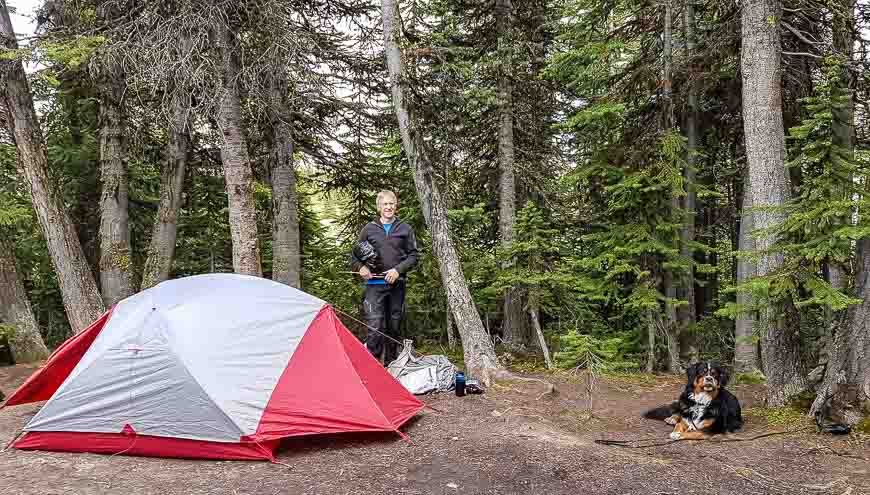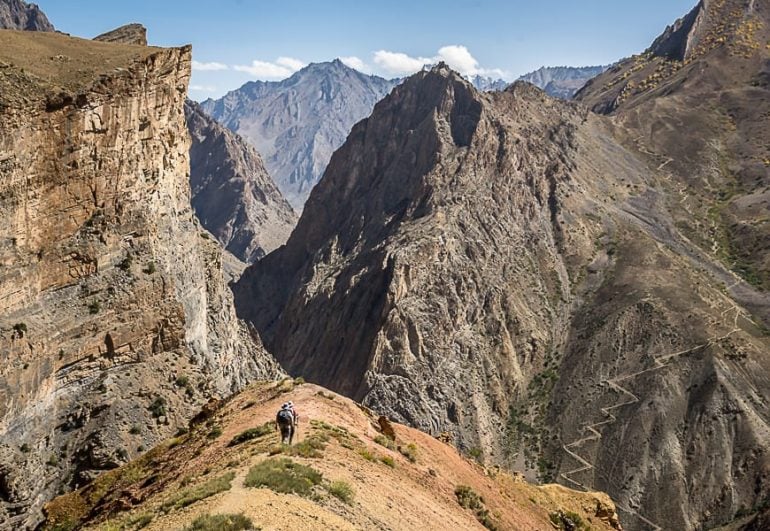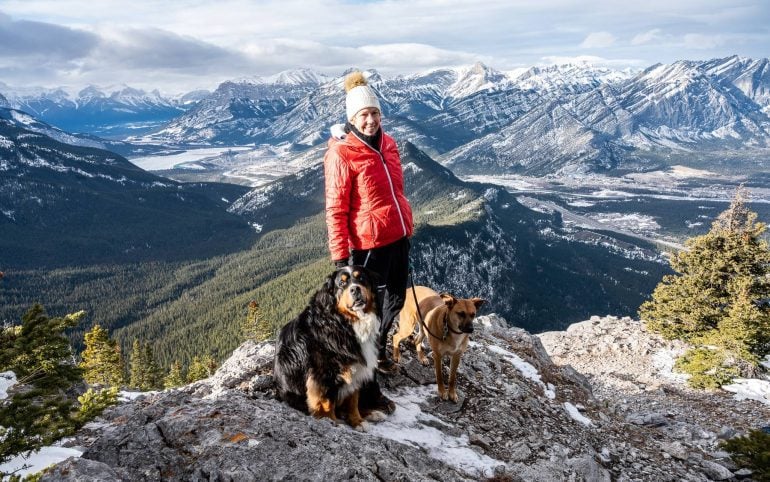Camping With A Dog: Tips from a Long Time Outdoor Adventurer
Camping with a dog is one of the most rewarding ways to spend time outdoors. I especially love the remote places we’ve explored with our dogs—whether hiking deep into the backcountry or paddling on wilderness canoe trips like Reindeer Lake in Saskatchewan or the Peace River in Alberta. There’s something special about being far from everything, where you don’t have to worry about other dogs or campers.
Over the decades, we’ve taken a series of dogs on countless camping and paddling adventures -and along the way, we’ve learned what works and what definitely doesn’t. In this guide, I’m sharing practical advice, real-life stories (including the mistakes we’ve made), and essential gear tips to help you prepare for your next camping trip with your four-legged friend
This post includes some affiliate links. If you make a qualifying purchase through one of these links, I will receive a small percentage of the sale at no extra cost to you. Thank you very much for your support.

Would you like to save this?
Why camp with your dog
I think dogs are like humans in that we both get bored with routine and need to mix up our day to day lives with adventures. I know how excited our dog gets when we start pulling out the camping gear. She knows something is up and certainly wants to be a part of it.
Going camping with a dog is a great way to bond. Our present dog is a rescue from Mexico who was beaten in her past. She was very afraid of being backed into a corner (think of the size of a tent) and she certainly had trust issues.
Within six months of bringing her home, we took off on a remote two-week canoe trip. Not only was it a great exercise in bonding, but she also learned that she could trust us, and we both really enjoyed her companionship. On a side note, after two weeks of trying to get her to swim, we gave up. She loves the canoe and frolicking along shore but doesn’t want to be pushed past that and we respect that.


Our biggest fails camping with a dog
- Forgetting that in prime bug season our dog would be completely miserable since we couldn’t use DEET or any other bug repellents on her.
- On our first cold camping trip with our Mexican dog, we didn’t consider how cold she would get – and ever since have been sure to bring something insulated to lie on plus a blanket and her dog coat.
- Running out of dog snacks. Not the end of the world but dogs like their treats as much as we do.
- Inadvertently, my husband set off bear spray in a tent with me and two dogs. We couldn’t get out of there fast enough. Fortunately, it didn’t get directed to any eyes.
- We learned quickly in a canoe you must set up some sort of rain cover so your dog doesn’t get soaked.

Know Before You Go: Planning a Dog-Friendly Trip
Check park regulations
Before you head to any one of Canada’s provincial or national parks – or state and national parks in the US, be sure you understand the regulations regarding dogs. They literally vary from park to park and in some cases from trail to trail.
A prime example is the Brazeau Loop multi-day backpacking trip in Jasper National Park. We planned to hike part of it over a long weekend one year with our dog Torrie. After our first night of camping, we learned that the Brazeau Loop that started a kilometre up from the campground travels through caribou country. And it was off limits to dogs because of the caribou in the area.
In fact, any trails in Jasper where caribou might be spotted are off limits to dogs including both Tonquin Valley and Skyline Trails. We had to change our plans and do a day hike instead that didn’t go into caribou country.
Check out the national and provincial park websites for information you need before you book your trip. I recommend you do a search along the lines of “what trails are dogs permitted on in Banff National Park? You’ll get this as an answer – along with the caveat that all dogs must be leashed at all times.
Ask a variation of that question across the board for all parks you plan to visit or risk some seriously big fines.

What to pack when you go camping with a dog
1. Sleeping system for dogs
If I was planning to go camping with a dog in the front-country, I would certainly bring the dog bed from home we always use or a slightly smaller version of it, especially if we were planning to be in a small tent.
In the backcountry on warm summer nights, we simply use a towel and try and rig up something with our inflatable seat cushion for more comfort. Or we bring a closed foam sleeping pad.
If we’re camping in the backcountry and it’s cold, then I think more seriously about how to keep my dog warm and comfortable. We carry a dog coat for our present dog Mila from Mexico as she doesn’t have thick hair. On top of that, we’ll bring a lightweight but warm down blanket and a foldable closed cell foam sleeping pad, so she doesn’t puncture it but gets insulated from the ground.

Food and water bowls
I portion out the food our dog needs and then depending on the activity level, add in about a quarter more per serving of kibble per day. I also pack one to two days extra food, in case something goes wrong, particularly on canoe trips when you might get wind bound. I also pack treats like the lightweight freeze-dried liver treats Mila likes so much.
Pack a collapsible water bowl that doubles as a food bowl. Choose a bowl depending on the size of your dog.

Leash, harness, collars and ID
We use a retractable dog leash. Sometimes these leashes are longer than what is permitted in a park, so check out regulations before you go. For example, in Alberta’s Kananaskis Country, leashes are supposed to be no longer than two metres. Use a little common sense too. On busy trails or in campgrounds we keep our dog close to us to avoid any unwanted confrontations. But frankly, if we’re in the middle of nowhere with no one around for miles, then we’ll give her a lot more leeway.
Don’t forget it’s not just people and other dogs you need to worry about. In some campgrounds, like Fish Lakes and Baker Lake in Banff National Park, porcupines are daily visitors. Don’t ruin a trip because you let your dog roam free and it now has a muzzle full of quills.
Our dog wears her collar with a dog license 24/7. Be sure your dog’s collar fits comfortably.
Lots of dogs are getting microchipped now – which is great if you have a dog that jumps fences and roams. Talk to your vet if this is something you’d want to do before you go camping with a dog.

First aid kit for dogs
Pack a first-aid kit specifically for your dog. Your vet may have some good ideas of items I haven’t listed here. Consult with your vet for your dog’s dosage for buffered aspirin, Benadryl, and Pepto Bismol. Note that Ibuprofen and Tylenol are toxic to dogs.
Our dog occasionally needs Metacam – a non-steroidal anti-inflammatory drug used to relieve pain, inflammation, and fever. I was able to buy a small container to take on camping trips. It covers off a lot of issues.
- A spare sock to help keep a foot bandage on
- Gauze bandages, cotton balls or Q-tips
- Liquid bandages for mild cuts on your dog’s paw pads
- Rubbing alcohol
- Antibiotic ointment
- Ear syringe
- Tweezers (in case you have a close-up porcupine encounter)
- Emergency ice pack
- Consult with vet on how to induce vomiting
- Vet wrap bandage
Should your dog carry a backpack ?
If we’re doing a two-to-three-night backpacking trip, we don’t usually bring a dog backpack. But if it’s longer than that and we want to bring our dog camping with us then we absolutely do.
We have always put dog backpacks on medium to large dogs but never on small dogs as the weight of their food isn’t as much of an issue. And we don’t overstuff the bags. It’s usually just kibble we have them carry. A waterproof dog backpack is a great idea if they like to go into the water.



Extra items to pack when you go camping with a dog
A compact umbrella is a great item to pack to prevent your dog from getting heatstroke on a canoe trip.
If you have a big black dog that looks like a bear from a distance (cue Rosie the Bernese Mountain dog), put a bright red bandana around her neck.
Don’t forget poop bags – especially when you’re within a few kilometres of a trailhead and they’d be easy to carry.
If your dog has a favourite toy that doesn’t take up a lot of room, you could pack that. Our dog prefers gnawing on sticks.

Do you need a life jacket for your dog?
Even if your dog is a good swimmer, you may run into problems if the water is cold. I’d recommend a dog PFD, especially if you’re paddling cold water or doing long crossings where capsizing could be an issue.
Choose a PFD like this one from MEC – that comes with a handle to help you lift them.

Can you use bug repellent?
It’s not a great time to go camping with your dog early in the season. Leave them at home or they will be truly miserable. On a canoe trip we did with our dog when bugs were bad, she did her best to cover herself with mud. Once we’d get to the campsite, we’d put up the tent ASAP as she quickly learned that was a bug-free zone.
Do not spray or apply DEET or any other drug repellents on your dog. They just start licking them off. Ask your vet if there is anything they can recommend that works.
Some people pack a bug shelter for their dogs. The other contraption that keeps deer flies and horseflies at bay is Dragonfly Wingman gadget that clips to their collar. Don’t forget a fly swatter too.

How to keep your dog safe outdoors
Wildlife awareness
Bears
In the Rockies, my number once concern re wildlife is running into a bear. Dogs may warn you about bears, but they aren’t likely to protect you. Hopefully the barking scares them off, but in some cases, they bring them to you.
The bottom line, keep your dog leashed, especially so if you’ve seen fresh scat or heard a bear in the woods. Make noise to let them know you’re there and read up on bear safety before you go. I also recommend that you have easy to access bear spray whether you’re hiking or paddling.
Porcupines
Porcupines are only going to be a problem if your dog is off leash. My experience in the Rockies is that they tend to hang around campsites so keeping them close to you is a good idea. As an aside anything with salt on it left outside your tent like boots and hiking poles, may get chewed while you sleep.
Ticks
We all hate ticks, and they are now prevalent in almost every region of Canada. They’re particularly bad in high grass, wooded areas, and leaf litter. In many areas tick activity peaks in spring and early summer.
Do a tick check of you and your dog after a hike. Kill ticks by drowning in rubbing alcohol or squishing them, but not if you have open wounds on your hands.
Possible tick repellents are scents that mask humans like lemongrass, mint and lavender.

Trail and campsite etiquette camping with a dog
There are lots of people with dogs that are doing a disservice to those of us trying to do the right thing. If you never pick up you dog poop, you allow your dog to run loose and jump on people, you don’t quiet a dog that barks too much – then unfortunately you are part of the problem.
Please people do the following so dog-friendly parks don’t change their regulations around dogs.
- Obey the leash rules and keep your dog close when trails are busy.
- Either pack up your dog’s poop when you know you can dispose of it easily in a garbage can, or bury it a long way off a trail, like you would human waste.
- Respect fellow campers. Many people only get two weeks of holidays a year – and they want those to be a non-stressful time. Don’t bring your dog to a campground if it barks too much or is too aggressive.
- If someone asks you to do something related to your dog in a nice way, smile and say sure. It’s not hard.
- Be respectful of wildlife. It is their home not ours.

Final Thoughts: Should You Take Your Dog Camping?
There are times when it’s not a good idea to go camping with your dog. If your dog is old, sick, overly anxious, recovering from an injury or very aggressive, leave them at home.
For the rest of you, start with short trips and build up. I love camping with a dog and hate the times we can’t take her – whether it’s too buggy, or if she isn’t allowed to come. Camping with your dog brings a special kind of joy – watching their tail wag, sharing quiet moments and falling asleep together in the tent. I hope you’re able to go camping with your dog one day.

More posts related to camping you might enjoy
- Camping for Beginners – What You Need to Know
- Tips For Camping in the Rain
- A Complete Guide to Camping in Kananaskis
- Everything You Need to Know About Camping on the Icefields Parkway
- Sawback Trail Hike: Johnston Creek to Baker Lake – a 4-day camping and backpacking trip I did with our dog
Click on the photo to bookmark to your Pinterest boards.





This was so timely! We’ve been hiking with our dog in Banff and Kananaskis as long as we’ve had him, but just started backpacking a couple of years ago. He’s a Border Collie and has a lot of energy, but I find I really have to manage making sure he gets enough sleep and doesn’t get too hot on trail (what with having a double coat) or he’ll really slow down on the second day. This year my intention is to be proactive about getting us on the trail every day earlier in the morning and making sure he naps in the tent once we’ve set up camp (he’ll lie down outside but won’t sleep). I’ve also picked up a cooling pad compatible with his harness that you just submerge into cold water. We’ll see how it goes! I’d love to bring him along on some longer trips, but want it to be a positive experience for him (and avoid any canine emergencies on trail…)
@Megan, A cooling pad is a cool idea for those super hot days.
This is a great article. Not sure if I missed it in the article but I also carry a dog sling when hiking / camping in other my dog. He is a big boy and if he gets injured we need a way to transport him. Just a thought
@Karen That is a great idea. I can’t imagine carrying our 55 pound dog very far.
This is a fantastic article, Leigh. Do you happen to have a hiking/camping cat as well? I’d love to read your tips and tricks for adventures with our sharp-clawed friends. If you don’t yet have furry feline friend, maybe you would like to adopt one?
@Justin Unfortunately I do not.